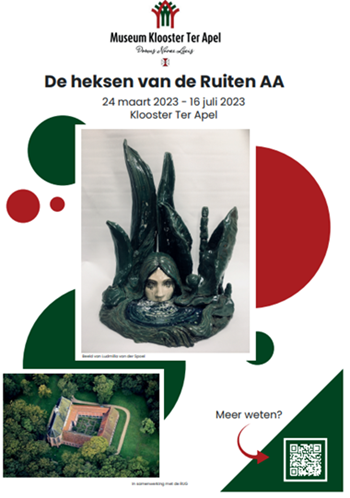De heksen van de Ruiten AA
Wist u dat tussen 1587-1597 meerdere vrouwen zijn veroordeeld als ‘toverse’ (Groningse benaming voor heks) en op de Geselberg in Vlagtwedde levend zijn verbrand? Het aantal omgekomen vrouwen tijdens de Westerwoldse heksenprocessen zorgt ervoor dat deze vervolging één van de grootsten is die ons land heeft gekend. Toch is deze gebeurtenis in onze geschiedenis onderbelicht gebleven. Daarom willen wij, studenten van de Rijksuniversiteit Groningen, in samenwerking met het Kloostermuseum Ter Apel het licht hierop laten schijnen.

Heksenprocessen
Aan het begin van de vroegmoderne tijd werden in heel Europa heksen vervolgd waarbij gruwelijke marteltechnieken werden gebruikt. De richtlijnen hiervoor waren te vinden in de 'Heksenhamer', een door de paus goedgekeurd boek uit 1486, waarin stond hoe je heksen kon herkennen en hoe je ze moest straffen. De heksenprocessen in Nederland vonden plaats in een tijd waarin sprake was van economische rampspoed, een crisis binnen het christelijke geloof en de oorlog met Spanje. Vrouwen van lage huizen werden als zondebok aangewezen in deze turbulente periode.
In Nederland zijn nog overblijfselen te vinden van heksenprocessen in de vorm van verhalen van nazaten. In Westerwolde gaat het verhaal rond van een beschuldigde vrouw die het gehele strafproces heeft doorgemaakt en uiteindelijk op de brandstapel is terechtgekomen. Het gerucht gaat dat prior Johannes Emmen, het kloosterhoofd van Ter Apel, aanwezig was bij haar proces. Maar wat is hiervan waar?
Tentoonstelling
De tentoonstelling: De heksen van de Ruiten AA, die op 24 maart tot 16 juli 2023 loopt in het Kloostermuseum, geeft antwoord op de vraag hoe de heksenprocessen plaatsvonden, wie hierbij betrokken waren en welke rol het klooster hierin speelde. Hierin geeft lokale kunstenares Ludmilla van der Spoel de veroordeelde vrouwen aan de hand van beeldhouwwerken een gezicht. Ga naar https://www.kloosterterapel.nl/en/ voor meer informatie over het klooster en de tentoonstelling of scan de QR-code.
